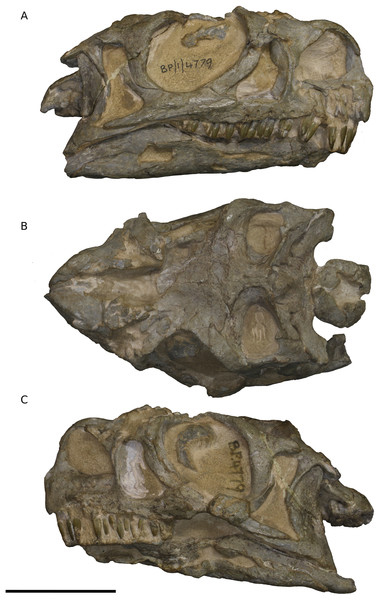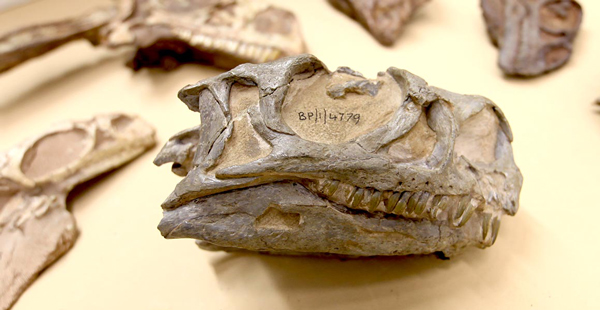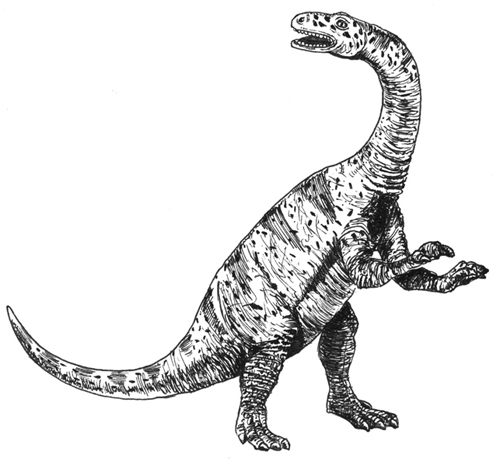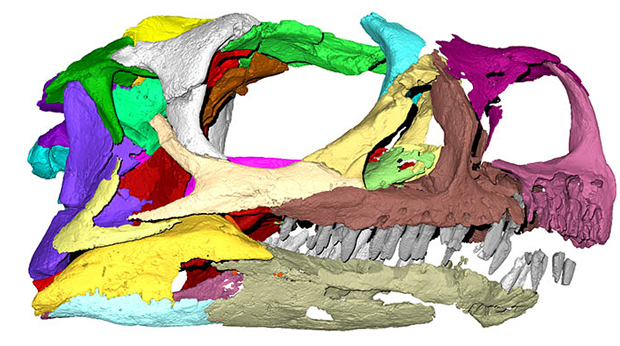The Sauropodomorph Ngwevu intloko “Hiding in Plain Sight”
The fossilised remains of a dinosaur that once roamed South Africa some 200 million years ago and that had lain mislabelled in a university vault for three decades has been identified as an entirely new species of dinosaur, a discovery that helps to demonstrate that ecosystems that developed shortly after the end-Triassic extinction event were much more specious than previously thought. The dinosaur has been named Ngwevu intloko.
A View of the Skull of the Newly Described Sauropodomorpha N. intloko in the University of Witwatersrand Collection
Picture credit: Kimberley Chapelle (University of Witwatersrand)
A New Dinosaur Species – Ngwevu intloko
The dinosaur has been named Ngwevu intloko and it was PhD student Kimberley Chapelle (University of Witwatersrand), whilst working with her supervisors mapping the extensive fossil material associated with Massospondylus (M. carinatus), that first realised that the well-preserved skull and postcranial remains could represent a new species. Hundreds of fossils including several nearly complete skulls have been ascribed to Massospondylus (M. carinatus), since it was described by Richard Owen (later Sir Richard Owen) in 1854. The skull (specimen number BP/1/4779), had been part of the University of Witwatersrand vertebrate fossil collection for years, but it had been thought that this was just an unusual example of this species.
Co-author of the scientific paper, which has been published in the journal PeerJ, Professor Paul Barrett of the Natural History Museum, London explained:
“This is a new dinosaur that has been hiding in plain sight. The specimen has been in the collections in Johannesburg for about thirty years and lots of other scientists have already looked at it. But they all thought that it was simply an odd example of Massospondylus.”
Views of BP/1/4779 – The Skull of Ngwevu intloko

Picture credit: Kimberley Chapelle (University of Witwatersrand)
A Diverse Sauropodomorpha Fauna of South Africa During the Early Jurassic
Using a variety of techniques including computerised tomography (CT) scans and three-dimensional bone mapping, the team identified a total of sixteen cranial and six postcranial characteristics that supported the establishment of a new dinosaur species. Deformation due to the fossilisation process and ontogeny were ruled out as the basis of these traits, thus leading to the conclusion that these fossils did not represent Massospondylus, but a different, albeit related dinosaur. Ngwevu was a bipedal omnivore with a small head, long neck and a robust, chunky body. It is estimated to have reached a length of about three metres or so. Analysis of bone cross sections indicate that the specimen would have been about ten years old when it died.
A Life Reconstruction of N. intloko
Picture credit: Everything Dinosaur
Potentially More Sauropodomorphs to be Identified from Massospondylus Fossil Material
Up until recently, Massospondylus (M. carinatus) was thought to be the only sauropodomorph represented by fossil material from the Lower Jurassic upper Elliot and Clarens formations of southern Africa, but there are now known to have been several different genera present, some of which were to eventually give rise to the huge sauropods of the Late Jurassic. Scientists are now starting to take a closer look at many of the supposed Massospondylus specimens, believing there to be much more variation than first thought.
Sauropodomorpha from the Elliot Formation include:
- Antetonitrus ingenipes
- Massospondylus kaalae
- Aardonyx celestae
- Ignavusaurus rachelis
- Arcusaurus pereirabdalorum
- Pulanesaura eocollum
- Ledumahadi mafube to read an article about the naming and scientific description of L. mafube: New Giant Dinosaur from South Africa.
This new research, helping to support the idea that there were many different types of sauropodomorphs in this part of Gondwana during the Early Jurassic, will help scientists to better understand how ecosystems recovered after the end-Triassic extinction event.
A Three-dimensional Digital Reconstruction of the Skull
Picture credit: Kimberley Chapelle (University of Witwatersrand)
An Interesting New Species of Dinosaur
Professor Paul Barrett commented:
“This new species is interesting, because we thought previously that there was really only one type of sauropodomorph living in South Africa at this time. We now know there were actually six or seven of these dinosaurs in this area, as well as a variety of other dinosaurs from less common groups. It means that their ecology was much more complex that we used to think. Some of these other sauropodomorphs were like Massospondylus, but a few were close to the origins of true sauropods, if not true sauropods themselves.”
This research shows the value of revisiting specimens in museum collections, as many news species are probably sitting unnoticed in cabinets around the world, an example of dinosaurs “hiding in plain sight”.
The scientific paper: “Ngwevu intloko: a new early sauropodomorph dinosaur from the Lower Jurassic Elliot Formation of South Africa and comments on the cranial ontogeny in Massospondylus carinatus” by Kimberley E.J. Chapelle, Paul M. Barrett, Jennifer Botha and Jonah N. Choiniere published in PeerJ.
The Everything Dinosaur website: Everything Dinosaur.









Leave A Comment